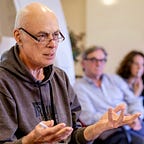The WKID Pyramid
Wisdom, Knowledge, Information, Data
Wisdom, Knowledge, Information and Data. I use this WKID diagram when teaching and writing about museums, though in a way it applies to any human organisation. It certainly applies to those which have interactions and transactions with others; for museums this means visitors, or as some prefer, customers. It is focused on flows upwards and downwards and the translations between the different ways what an organisation is doing are measured, analysed and acted on.
Although the pyramid diagram doesn’t expressly show this, a fundamental idea in this upward and downward flow thinking, is that traceability is easy. Whether the information is statistical or financial, it should always be the case that translation from one level to another is transparent; the linkages between data and information and information and knowledge should be simple to understand. This ‘transparent flow’ should extend from daily, weekly and monthly management information through to the organisation’s Report and Accounts. Though this seems a very obvious point, it’s surprising how often in my experience this isn’t the case, with management teams and Boards relying on the finance director to ‘explain the figures’. However without this clarity and understanding, management, leadership and governance can’t function properly. The successful leader is continuously monitoring the exchanges in his or her organisation between data, information, knowledge and wisdom. The managerial mindset tends to stay locked at the information and data level, to be instrumental and implementation focused. The leader, on the other hand, is continuously translating information into knowledge and knowledge into wisdom.
Getting these flows working well is the foundation of good governance. The leader, and his or her senior team are principally interacting with the Board at these two top levels, not looking at detail but building a picture of patterns of change over time. The time horizon lengthens as you move up through the pyramid and contracts as you move down. The top levels are therefore the sphere of strategy and the lower levels, tactics.
One of the classic problems of organisational design and development is the circular movement between information and knowledge and then knowledge back to information; the reciprocal relationship between the two is not interrogated frequently enough by the management and leadership teams. It’s only when timely, accurate and appropriate information is gathered longitudinally that the organisation can grow its knowledge base. Equally, the organisation and its leader or leaders have to have spaces and methods to reflect on the relationship between knowledge and wisdom.
Broadly; data is time, place and activity specific, information is a 1st level gathering of data and is less time and place bound, and knowledge gathers information from many time, place and situation intersections. Thus, as we rise through the pyramid these specific ties lessen; data and information tend to be location specific, whereas knowledge and wisdom are more situation independent. In human societies wisdom is the level of intergenerational learning. In organisations, there is no exact equivalent though we often speak about succession planning, which is a way of thinking about the importance of carrying the accumulated wisdom across generations of CEOs and Boards. Clearly, wisdom cannot be held to be rigid, a set of doctrinaire beliefs or nostrums that apply to any human situation at any time. Wisdom in this intergenerational sense has to include both persistent themes and variation.
The WKID diagram, which I originally drew after reading Stewart Brand’s ‘The Clock of the Long Now: Time and Responsibility’, is based on the diagram in the book, which I call the ‘time-wave’ graphic (above). Brand’s diagram is a simple but powerful way of expressing the fact that human societies evolve and change at different speeds. The base level in Stewart’s diagram is nature, the longest slowest wave. Above this is culture, then governance and so on. The fastest change is at the level of fashion, where the wavelength is very short and the amplitude quite low. Governance isn’t politics; it has a longer slower reach than the rough-and-tumble of elections and government. One of the effects of the 21st-Century age of the network and social media is that our valuation of good quality governance has declined while politics and fashion have moved much closer together.
For museums which are intergenerational, long wave organisations, the WKID pyramid inverts this. This is to express the fact that wisdom in organisations is incredibly important, and so it’s long wave is placed at the top of the diagram. Understanding this and ensuring the two-way flow between wisdom and data suitably parsed, is a central organisational challenge.
